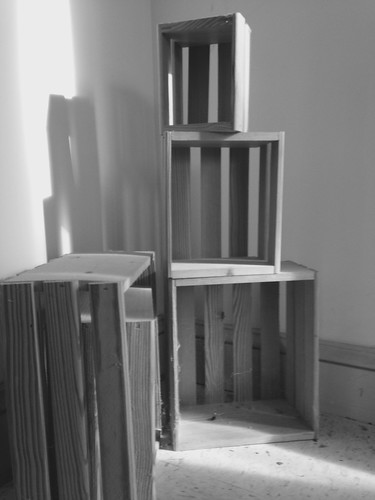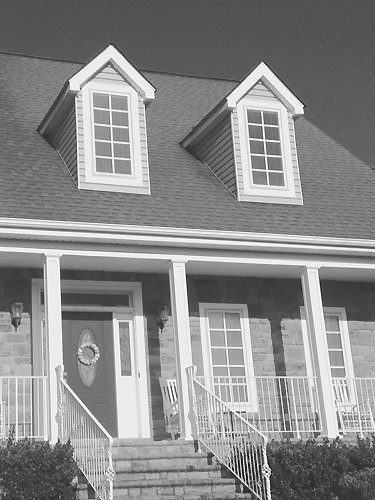
Phillip Johnson, the architect famous for his 'Glass House' also created on his Connecticut estate a monument to his college friend Lincoln Kirstien. Kirstien was a poet, connoisseur, philanthropist, and cultural figure in New York City. He helped found the New York City Ballet. Johnson's monument to his friend, the Kirstien Tower, is a steep stairway of stepping stones into the Heavens. A fitting tribute to a creative spirit!
In describing the tower, Johnson refers to the term 'Safe Danger.' Indeed the steep ascent requires stepping into the unknown and creates a feeling of excitement. Every venture into the creative world should. Thus the pathway to my studio, originally created by the need for an economical solution became a similar stairway into creative wonder. I don't think the Kirstien Tower was a direct inspiration so much as a wonderous connection to my own bit of 'Safe Danger.'
I got fascinated by blocks one day. Blocks, like a child playing with blocks, right? Do you suppose I’m in my second childhood? Anyhow, I took the concrete blocks and just piled them up in odds ways, which you’re not supposed to be able to do with concrete blocks and cantilevered them. And then I made out of the tower a stairway, a very dangerous stairway. You all should go up it. Because, again, you won’t go all the way; most people do not go all the way; I always go all the way. But there, on the top of that tower, there’s nothing to hang on and the steps are very high and the view is very nice but then you have to get down again. Have you ever climbed a mountain? You know how these ice picks are such fun because you can go straight up – then you have to come down, terrible.”-- Phillip Johnson [1.]
My granddaughter and I LOVE to play at blocks. We can sit on the floor for hours building Elsa's Ice Castle or Cair Paravel. We always pile our blocks in odd ways. That's the joy of it all! When I was about seven or eight, I built my first monument. My Aunt Molly had a wonderful live-in companion named Lizzie Harrison. Lizzie was the best marksman I ever knew. She had had a tough life but she had a sparkle in her eye... it came out when she'd teach us kids how to catch tadpoles or smallmouth bass in the pond. Lizzie had one more amazing talent... she made the BEST cookies a seven-year old boy ever tasted!
The shop, which was our family business that manufactured chicken coops, was near Aunt Molly's house and the men always brought over a huge pile of off-cuts so Aunt Molly and Lizzie had firewood! It towered into the sky and to a seven-year old boy it was the biggest blockpile in the world.
You can imagine my father's alarm when he saw me on the top of the thing! I went up there to build a Monument to Lizzie's Cookies! Someday Macaroni and Cheese will have to have its own monument, but that is a story for another day. In the end, I think dad admired my grit and Lizzie was certainly touched by my attempt to honor her cooking skills. I don't remember being punished for the adventure. And so, my life has continued to spin off a variety of attempts to honor those who are important to me. There are the wedding daisies planted by my lovely wife, to commemorate our daughter's wedding. There is the magic garden, celebrating LOVE and WONDER. There is the broken trellis that I leave because my son almost cleared it in a rather spectacular leap... and then there is the pathway.
The stepping-stone pavers were initially a temporary solution, but they took on their own special significance. When I was setting them in place, one of my wife's friends was visiting and her six-year old daughter wanted to 'help.' Little Emma's participation made the job more than a mundane task. I once had a wonderful assistant in the studio, a brilliant young artist/designer/writer named Kristina, who could bound up those irregular pavers in heels! That reminded me of Johnson's tower and 'safe danger!' The pathway originally was lined with pine trees which became a sort of magic forest that one could pass through. Any thoughts of a code-compliant proper walkway were long gone now. I grew to love the walkway and its 'safe danger.'
Safe, sensible access could be had by driving up to the gate at the other side of the studio anyway. As a non-public space it was grandfathered away from a lot of unnecessary overbuilding. But the last few years I was keeping the path clear but not really maintaining it. It was showing its age. In the evening the stones were not so visible anymore and the journey to the studio required a flashlight. As I tackled the overgrown studio grounds it soon became apparent that the old path needed to be brought back to life.
I worked the landscaping so light fell onto the path beneath the pines... rather like the glow in the Lantern Waste of Narnia. Now I could imagine my granddaughters having adventures there. I had read about making paver stones glow in the dark with special paint. I tried it. It was a resounding flop, but the addition of lighter paint to the edges of the pavers defined them nicely. The walk now was a passageway. It lead somewhere.
My mind wanders to a pathway at Oxford's Magdalen College, and an Autumn evening, September 20th,1931. C. S. Lewis took a walk there with J.R.R. Tolkien and another friend, Hugo Dyson along the Cherwell River in the Magdalen Fellow's Garden along a pathway known as Addison's Walk. Lewis had become an atheist, then a believer in the sense that he acknowledged the existence of God. Still, he was resistant to personal faith in Him. He and his friends talked of how they loved mythology and shared a lifelong fascination with it. It was sad, Lewis declared, “to think that classic tales of courage, beauty, sacrifice and virtue are all untrue and ultimately worthless.”
Tolkien replied: “No, they are not lies. Myths contain great spiritual truths.”
In a letter to Arthur Greeves, Lewis remembers the evening:
He (Dyson) stayed the night with me in College -I sleeping in in order to be able to talk far into the night as one could… Tolkien came too, and did not leave till 3 in the morning: and after seeing him out by the little postern on Magdalen bridge Dyson and I found still more to say to one another, strolling up and down the cloister of New Building, so that we did not get to bed till 4, It was really a memorable talk. We began (in Addison's walk just after dinner) on metaphor and myth --interrupted by a rush of wind which came so suddenly on the still, warm evening and sent so many leaves pattering down that we thought it was raining. We all held our breath, the other two appreciating the ecstasy of such a thing almost as you would. We continued (in my room) on Christianity: a good long satisfying talk in which I learned a lot: then discussed the difference between love and friendship - then finally drifted back to poetry and books.
On Sunday he came out here for lunch and Maureen and Minto and I (and Tykes) all motored him (Dyson –taught English at Reading University) to Reading - a very delightful drive with some lovely villages, and the autumn colours are here now.
I am so glad you have really enjoyed a Morris again. I had the same feeling about it as you, in a way, with this proviso - that I don't think Morris was conscious of the meaning either here or in any of his works, except ‘Love is Enough’ where the flame actually breaks through the smoke so to speak. I feel more and more that Morris has taught me things he did not understand himself. These hauntingly beautiful lands which somehow never satisfy, - this passion to escape from death plus the certainty that life owes all its charm to mortality ~ these push you on to the real thing because they fill you with desire and yet prove absolutely clearly that in Morris's world that desire cannot be satisfied.
The Macdonald conception of death - or, to speak more correctly, St Paul's - is really the answer to Morris: but I don't think I should have understood it without going through Morris. He is an unwilling witness to the truth. He shows you just how far you can go without knowing God, and that is far enough to force you… to go further.”
(Lewis’ letter to Greeves dated Sept 22nd 1931)





































